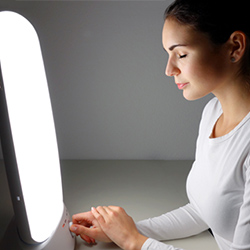
Winter can bring a lot of fun to life, like holidays with family, outdoor winter activities, and cozy days indoors.
But adjusting less sunlight can be difficult.
Dr. Stuart Anfang, Vice Chair of Psychiatry at Baystate Health, shares some tips for coping with the change in the seasons and how to handle seasonal affective disorder.
What is SAD and what are the symptoms?
SAD stands for seasonal affective disorder. It is a type of depression that's related to changes in seasons and most prevalent during the fall and winter months.
Scientists don’t know exactly what causes SAD. Some believe people with SAD may have lower serotonin levels, which can affect moods. Others think people with SAD may produce too much melatonin, which could make them sleepier.
It could also just be the result of your body getting out of sync during transitions like Daylight Saving Time.
SAD symptoms include:
- Fatigue
- Feelings of despair
- Anxiousness and guilt
- Loss of interest in social events or normally enjoyable activities
- Change in appetite
- Craving for sugary and starchy foods
- Changes in sleeping patterns including oversleeping or difficulty sleeping
- Thoughts of death or suicide
How is SAD diagnosed?
Talk to your doctor if you think you might have SAD. They may give you a questionnaire to see if you meet the requirements.
According to the National Institute of Mental Health, you could have SAD if you:
- Show signs of depression or the SAD symptoms
- Experience symptoms during specific seasons two years in a row
- Have frequent depressive episodes, more so than at other times in your life
How long does SAD last?
SAD symptoms can show up year after year.
When you do have symptoms, you may notice them during the winter of summer seasons for about 4-5 months.
Who can get SAD?
Anyone can get SAD, but it’s more common in women than men. It’s also more common in people who live in northern regions, where hours of daylight shorten in the winter.
People with major depressive disorder or bipolar disorder are also more likely to have SAD.
Does SAD get worse with age?
The National Institute of Mental Health says SAD oftentimes starts in early adulthood.
But SAD does not get worse with age. Discover Magazine says that may be because older people tend to spend more time indoors, making seasonal sunlight changes less jarring.
How to treat SAD
Make sure you talk to your doctor to see what treatment method is best for you:
- Light Therapy: Sitting in front of a light box for 30-45 minutes each morning during your symptom months could help you. The extra light could help supplement the sunlight you’re missing during the winter months.
- Talk Therapy: This is also known as psychotherapy. Speaking with a professional, sometimes in a group session, can help you learn way to cope with your symptoms.
- Antidepressant medications: There are some medicines that can adjust serotonin levels. Make sure to talk to your doctor about potential side effects.
- Vitamin D: Some people with SAD also have a Vitamin D deficiency, so taking a supplement may help.
Winter Blues
Not everyone gets SAD, but you may still feel a little down when the clocks change and the days get shorter.
Try to adjust your schedule to get more sunlight. If you can’t fit it into your schedule, try catching up on the weekends.
Stay social
While it may be unsafe, especially for the elderly, to venture outdoors in the cold weather with slippery sidewalks and roadways, it doesn’t mean people have to become hermits.
Invite friends or family over your house or have a virtual get-together.
Be active
It’s also important to stay active during the winter months. Exercise can raise your spirits and improve your energy. If you can’t get to the gym or take a walk in the cold winter’s air, there are plenty of exercises you can do at home to keep you physically and mentally fit.
Find things to do
Besides exercise, make sure you have activities to keep you busy.
Read a good book. Turn on the television and have a marathon catching up on your favorite shows. Listen to the radio. Call your friends. You can even get a head start on your spring cleaning.
Pass up on the drinks
If your mood is already sullen, alcohol, which is a depressant, can makes it worse.
When to get help
If self-treatments aren’t helping, and you are feeling sad, crying, not eating, or have a general feeling of hopelessness, call your primary care physician who can see you or recommend a mental-health professional.
"Help and effective treatment is available. No one should suffer in silence," Dr. Anfang added.